Scott Dixon: The Motor Sport Interview
Long-serving six-time IndyCar champion Scott Dixon on his desire to equal AJ Foyt’s tally, ‘reversing’ into Dario Franchitti and why there’s more to an oval track than meets the eye
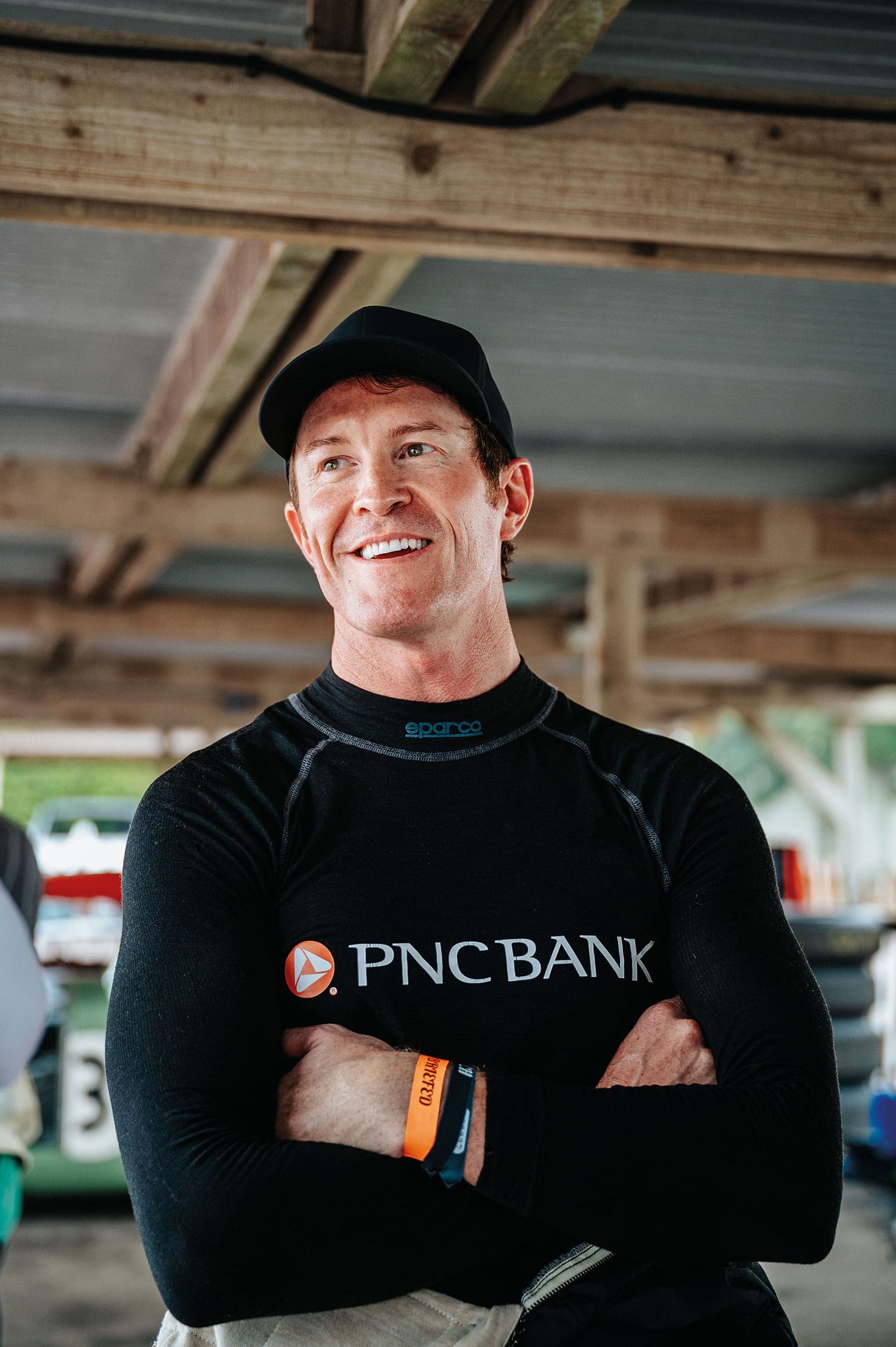
Jayson Fong
Scott Dixon is one of the most successful IndyCar drivers of all time. The New Zealander is six times a champion, has more than 50 IndyCar race wins and this is his 21st season with Chip Ganassi, the sport’s longest ever partnership. Having started in karts he rose quickly through the lower formulae, heading not for Europe but to America where he won the Indy Lights championship before graduating to CART with PacWest in 2001. The partnership with Ganassi began in 2002 where his team-mates included Dario Franchitti, with whom Dixon was reunited at the Goodwood Revival, sharing an E-type Jaguar.
We caught up with Dixon between IndyCar duties to look back on an extraordinary career. And team-mate and fellow IndyCar champion Franchitti couldn’t resist joining in when it came to their Revival strategy.
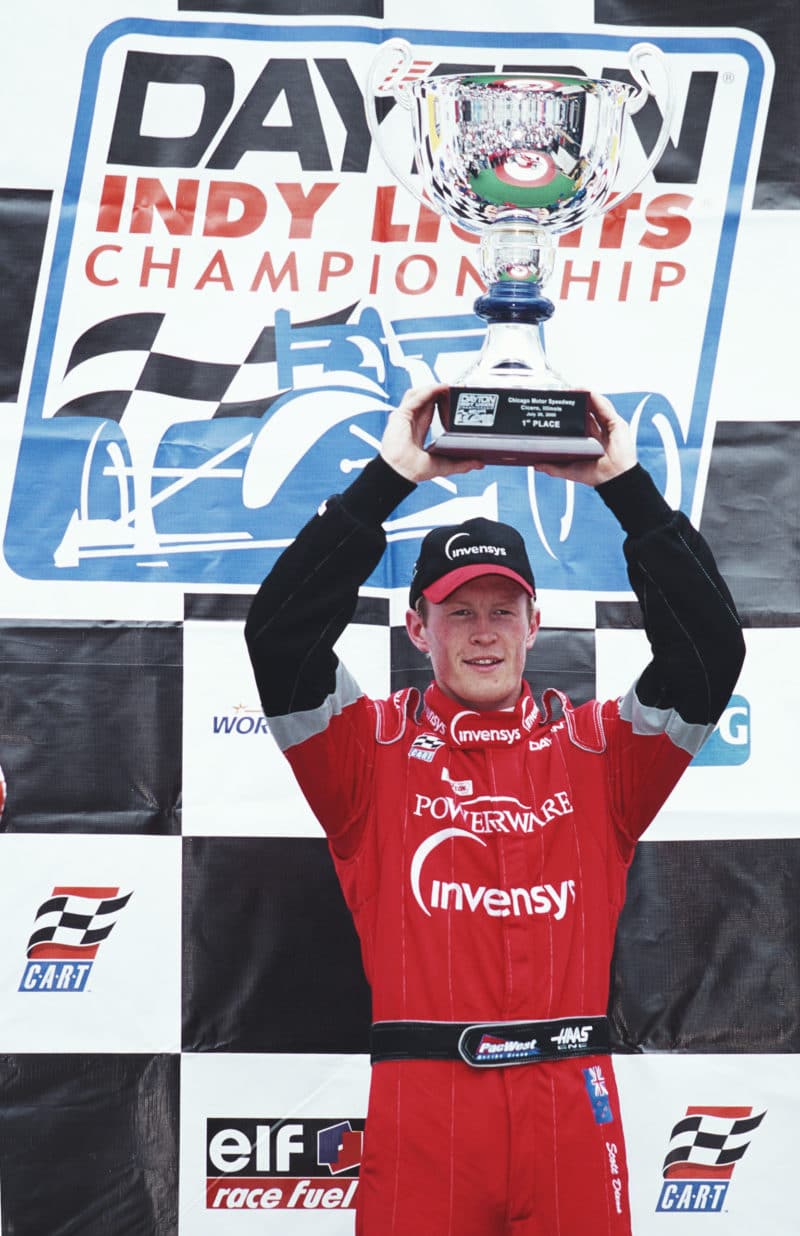
By 2000 Dixon was in the US racing – and winning – in the Indy Lights series
Motor Sport: You started racing karts as a boy in New Zealand. Were you inspired or influenced by the success of Chris Amon, Bruce McLaren and Denny Hulme?
SD: “Yeah, sure, that was a big influence. The whole heritage of New Zealand motor sport from the 1960s and ’70s, which also included a lot of the grand prix drivers coming down to race in the Tasman Series. This is my dad’s era. He was a racer, and so most of the stories came from him. It was a very strong era for New Zealand and of course the McLaren name remains in top level racing to this day. My mentor was Kenny Smith, a bit of a legend as a driver in New Zealand, who would play a big part in my early career. So yeah, it was a special time, and that heritage still drives us today. It’s great for me to be a part of the country’s motor racing history.”
Tell me about those early karting days where so many great drivers have learnt their racing skills?
SD: “We moved back to New Zealand when I was five. I was born in Australia where my parents had been working, and my dad was racing. My cousins were competing in karts in Wellington and when I was seven I was able to have a go in one of the karts at the end of a raceday. That’s how it all kicked off.
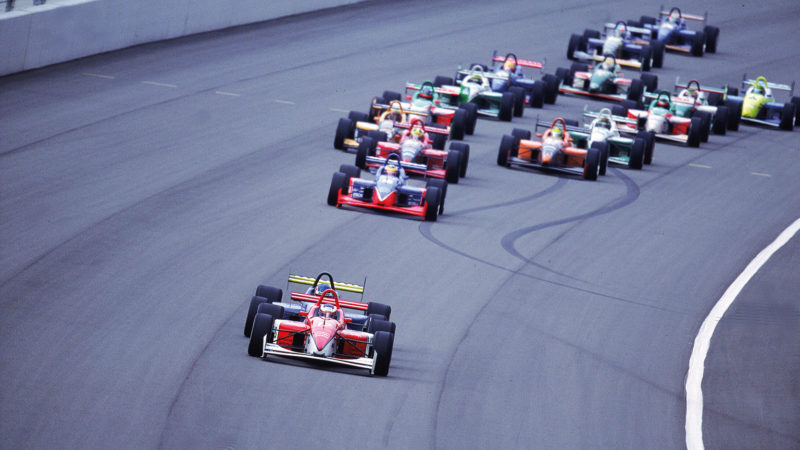
Indy Lights in 2000, leading at Fontana, California
“I moaned at my dad for weeks to get me a kart. He bought one and I’ve been racing ever since. I just loved the driving. I remember to this day getting into that kart, the feeling of the speed, being so low on the ground, and controlling something that felt so quick at that age. It was the exhilaration, the sheer speed you thought you were doing! When you’re seven years old it’s quite wild, quite a machine you’re driving. You learn the fundamentals, how to set it up, how to drive in the wet, observe other drivers’ weaknesses, how to fix problems, identify overtaking opportunities. All of that applied when I moved up into cars when I was 13. Karts are still the strongest foundation you can have for any kind of racing career.”
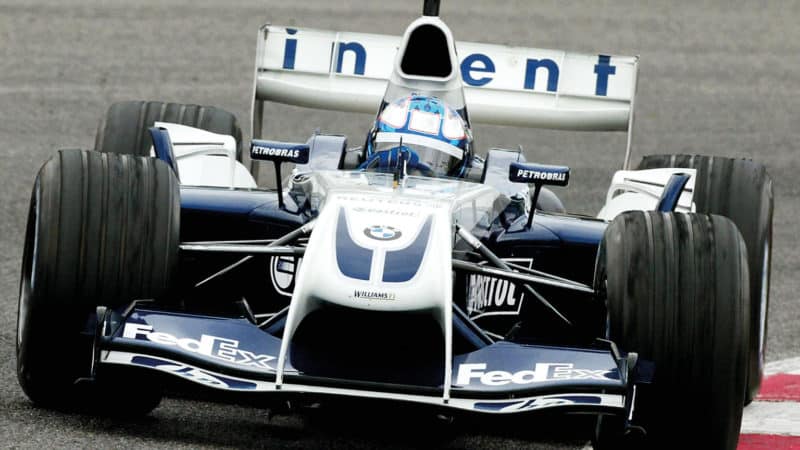
At Barcelona in 2004 testing for Williams
You did all the categories up to Formula Atlantic in New Zealand, went to Australia for two years, did Formula Holden, the equivalent of F3000. While most headed for Europe you instead went to America. Why was that?
SD: “Yeah, that wasn’t really the plan. We were looking at Formula 3 in England with Alan Docking but Kenny ended up talking to Vern Schuppan and Stefan Johansson about Indy Lights.
“So on the way to England we did a post-season test at Sebring. There were about 20 cars. We did a day with PacWest, a day with Stefan’s team, and I came away quickest of everyone. Stefan wanted to do a deal right there and then. We had a group of investors that Peter Johnson had put together back home but we didn’t have a lot of money, so this was our best option. We took Stefan’s offer straightaway. It seemed like a crazy deal at the time. So we never made it to Europe. It was one of those life-changing moments, and I’ve been in America ever since.”
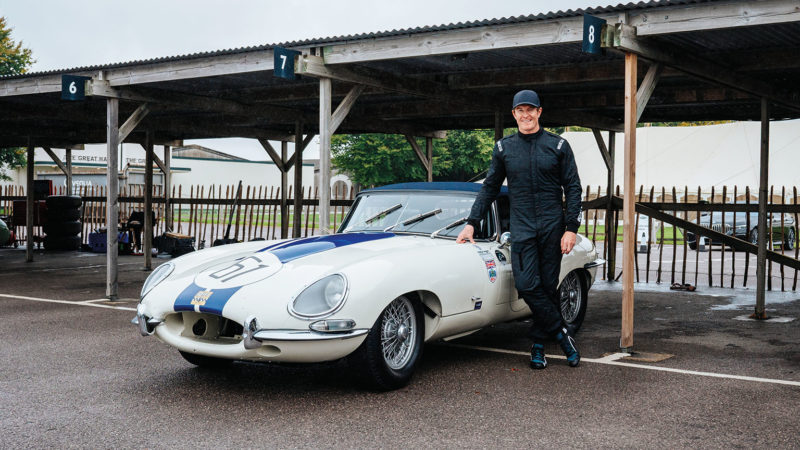
Dixon was racing Gregor Fisken’s Jaguar E-type at Goodwood with Dario Franchitti, a former IndyCar team-mate
How important has Stefan Johansson been to your career over the years?
SD: “Very important, along with my dad, Kenny, the Giltraps in the early days. Stefan helped with funding early on. He’s still my manager, and we’re still working together today. He’s a fun guy, a great friend, and he knows everyone in motor racing in America and in Europe, so yeah, it’s been good.”
In 2004 you tested for the Williams F1 team. Was that a realistic opportunity for you to go grand prix racing?
SD: “It’s hard to know. At the time I’d just won the 2003 IndyCar championship, so I was in an interesting space, and it seemed there was a vacant seat at Williams. We did the first test at Paul Ricard, it went really well, but between that and the Barcelona test they took Mark Webber back. Mark was a great choice for them and he was under contract with them anyway. So I knew the race seat was no longer an option.
“There could have been a testing option but I didn’t want to get lost in the wave of things going on so I decided to continue with IndyCar which was very competitive and
I was really enjoying it. The Williams was an amazing car to drive. That first test was really good. The second one we had mechanical problems, and it rained a lot, but it was an experience I will always treasure for sure.
“I loved the Williams-BMW. The car did everything you’d want a car to do, whereas an Indycar doesn’t do much right, doesn’t do what it should. You’ve got to manhandle it. There’s no power steering, but that’s kinda fun because you have to drive around a lot of different things.
“Speaking to guys like Romain Grosjean, and other guys who’ve come across from Europe, this is what they enjoy, learning to adapt and drive the car differently.”
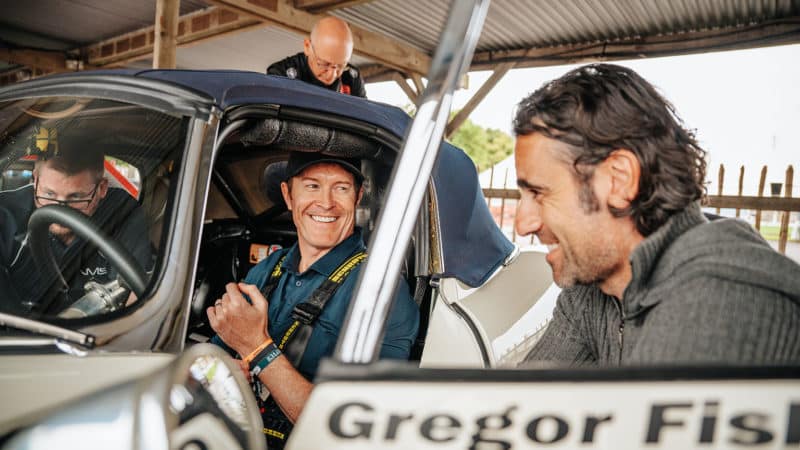
Franchitti giving tips on braking to his former IndyCar colleague…
Do you regret not getting a grand prix drive or has IndyCar given you everything you expected, and wanted, as a front-running driver?
SD: “It’s not about regrets. I don’t spend time analysing the ‘coulda, shoulda, woulda’. You move on. The tests were simply a great experience. It’s not for me to talk about Formula 1, what’s good or bad. I haven’t been there, but in IndyCar today there are 10 to15 drivers who, if they get it right, can win. This has been a pull for a lot of European drivers, and there’d be a lot more, but there are no seats. It’s a good moment for IndyCar. The only thing holding it back is a third engine manufacturer. That’s what it really needs. The new rules, and the way the teams are formed, means there are no small teams any more. It’s in a good place, very competitive. This year, for example, there was all to play for, three or four of us in with a chance to win the title.”
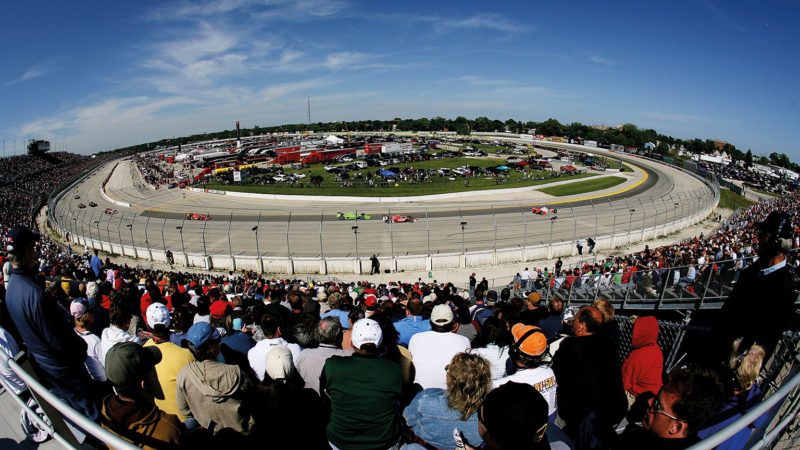
Dixon, running second, at the Milwaukee Mile in 2009 – a race he’d win for Chip Ganassi
Talking of winning titles – you were reunited with your Chip Ganassi team-mate Dario Franchitti at the Goodwood Revival recently (more on that later) and he took a couple of championships off you in 2007 and 2009.
SD: “Yeah, he did, in ’07 at Chicagoland, he was with Andretti, we hit each other, I was running out of fuel and spun in front of him on the last lap. He says I reversed into him, but I’d have been a magician to get reverse that quickly. I guess he just couldn’t drive around me! Then in ’09, we were both at Ganassi, and at Homestead I had to pit for fuel in the last eight laps and Dario’s win gave him the title. We never fell out with each other, it never got nasty. We worked really well as team-mates. It was great, the dream team. We both pushed the team forward. I heard that Chip said it was the perfect pairing, and in ’09 we won more than half the races. OK, you have your moments behind closed doors. That stretch 2008 through ’13 was pretty full on, but was a great time. I don’t know what it is about the IndyCar family. Maybe it’s the environment, the danger factor. There has to be some respect between the drivers.
“In the period we’re talking about we lost close friends and that brings you together, makes you understand the bigger picture. Man, that era was tight. We were a travelling circus; we were close. It’s different now. New generations coming in, people from lots of different places, and I guess the earlier times are my fondest memories.”
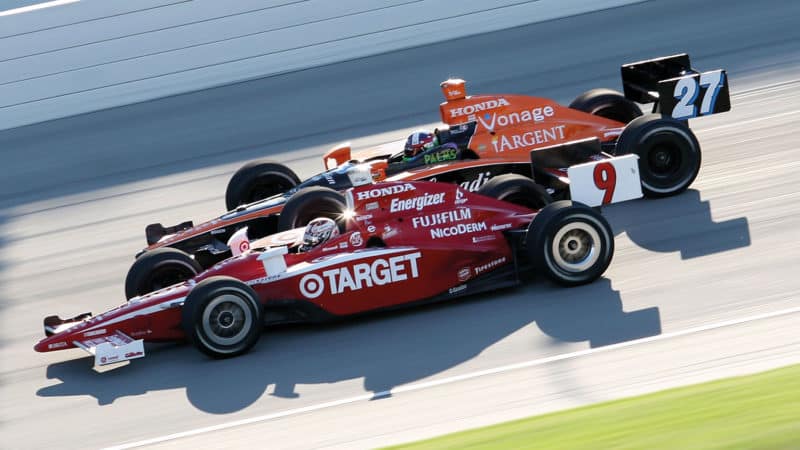
Dixon side by side in 2007, with Franchitti (No27) driving for Andretti
The skills of oval racing are something of a mystery for many European fans. What is the secret of success on these ultra-quick racetracks?
SD: “The biggest thing is to be comfortable with the car. After crashing Indycars on an oval I had to wrap my head around the fact that it’s very difficult to drive beyond the car. You have to fix the car whereas on road courses you can manipulate it. If you have excessive handling problems on an oval you’re gonna hit the fence. “Respect – you need to respect just how difficult it is to get it right. That was my problem coming in. I thought, ‘It’s only two corners, how hard can it be?’ You might be brave and quick for a short time but that doesn’t work for long. The situation overcomes you.
“Oval raceability has changed over the years. It’s never one thing, evolving from the pack racing that we used to have, from the multiple lanes we used to run at flat tracks like Milwaukee. That’s not as applicable now. Ovals may look basic but they’re crazy different from each other, even between places like Iowa and St Louis for example. I’ve always loved oval racing. In qualifying you can be a quarter or even half a second faster at one end and slower the other end. That’s a lot of time on an oval. One time at Milwaukee, Dario and I were going for pole. He was quicker one end, I was quicker the other. The margins are so tight. For me it’s not about the speed. The speed is kinda relative. The big jump used to be from Indy Lights to CART, or IndyCar, when they were brutal cars. These days the cars don’t have so much power but we’ll have more in 2024 with the new hybrid engines.
“Back in the day, when you came back from a winter break, you got on the oval, and you thought, ‘Holy shit these cars are fast.’ That’s exhilarating. At Indy, you’re doing 230mph and everyone else is within 5mph, so it’s relative. It’s when it goes wrong, that’s when you get the big wake-up.”
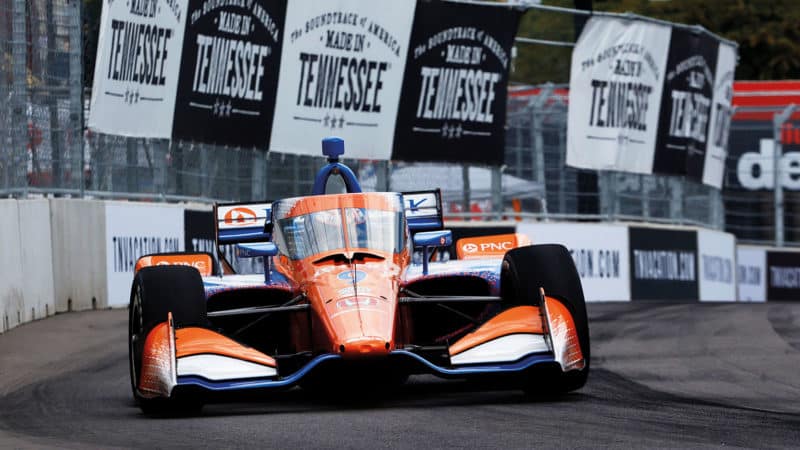
Now in his 21st year racing in IndyCar, Dixon is still winning races – his latest was at Nashville in August
It seems that strategy is all-important. The races are like games of chess, or snakes and ladders, on the pitwall.
SD: “It is and a smart strategy helps, of course. Depending on how far back you start you’re looking for options. Yellows create those options and often it’s then a compromise – how many laps the tyres have done at a re-start. You can become very vulnerable, like I was at Nashville. A crash had taken us out of a straightforward strategy and I already had 45 laps on the tyres at the last re-start. So then you’re compromising to achieve the best result.
“When I won my first IndyCar race we qualified pretty poorly, but we kept on topping up with fuel at every caution, and by the end I was the only one who could make it to the end. IndyCar is fun like that because, even when you think you’re out of it, you still have an option to win. Some people may not like that but we don’t want boring races either. Strategies and cautions mix things up, which is fun and exciting. I enjoy that.”
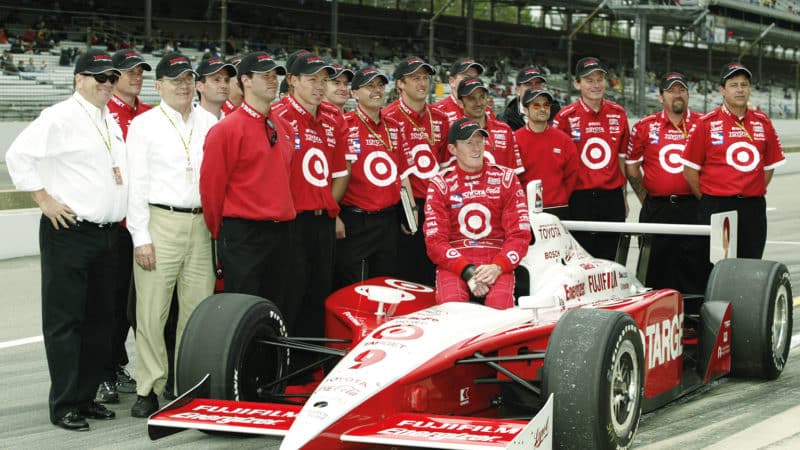
IndyCar drivers’ champion in 2003 with the Ganassi team
Tell us about the rivalry between the two giants Ganassi and Penske. Do they approach winning in different ways?
SD: “I’ve been with Ganassi for 21 years now so it’s hard for me to expand on that, but we do follow and analyse what the opposition is doing. The goal is the same for both teams. That’s to win and to do anything to achieve that, but I guess there are differences. We work well across the whole team. It’s a very open book. Maybe Penske is a more singular operation with each of their entrants. What I really love about Ganassi is that it’s very black and white, very straightforward, all about winning. It’s all that Chip cares about. He’s very hands on. Racing is his only business, whereas Roger has an empire of many different things. They’re both super-competitive of course.
“You look around for what might be the right opportunity, but it’s been a pretty easy decision for me to stay with Ganassi. I’m a black and white kind of guy too. I just want to win. I relish the challenge of the new kids coming in. I welcome it. They push the team forward and inter-team competition is the best competition you can have. The younger ones coming through is inevitable. There’s nothing you can do about that.”
After a hectic season you’re sharing an E-type Jaguar with Dario at the Goodwood Revival and today you’ve had a few laps to see where the circuit goes.
SD: “I love Goodwood. I went to the Festival of Speed for the IndyCar anniversary celebrations, and my wife Emma and I got married in Goodwood House in 2008. She’s from Wales – we both like England. I’ve been a spectator at the Revival, and we watch it online after the IndyCar at Laguna Seca in September. This year it works so I can come and race at the end of our season. I’ve always wanted to do it. Man, I’m just a racer like the rest of us and it’s fun, it’s back to basics.
“I want to try different things, not just this once, but for a long time to come. I did a few laps today for the first time, in Gregor Fisken’s beautiful Jaguar, and it was raining, very slippery. It was wild, I loved it. I haven’t done heel-and-toeing with a manual gearbox since I was a teenager, and I don’t think I’ve ever had less grip, but the car is great, a lot of fun. The circuit seemed quite small and compact first time out but it’s cool, has a nice flow like all the old tracks on natural terrain, and it’s very fast, pretty much an oval! The risk versus reward is big. You’ve got grass and then a bank, so I’ll play it on the safe side.
“Who will start the race? Well, hopefully Dario, so he can get a 20-second lead, hand over, and I can just cruise. Sure, I’m joking, but most times I’ve done a team sharing event I’ve crashed soon after the start. That’s when most accidents happen. I later worked that out.”
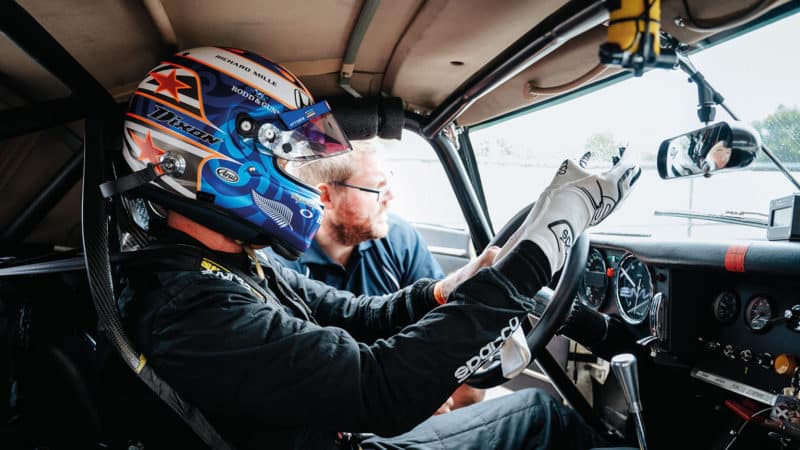
Practice laps at Goodwood
Dario Franchitti enters stage left…
DF: “He’ll wear the brakes out. He’s heavier on the brakes than me.”
SD: “I’ll be in fuel save mode mate, coasting.”
DF: “Scotty and I will be good. He’s the best team-mate I’ve ever had and he won’t have a radio so he can’t shout at me in the pits.”
SD: “Yeah, that’s a shame. I can’t yell at him, and no spotters either. Maybe we can rig up a cellphone and ear pods. But the strategy is always the same – to win. Let’s see how competitive we are. The cars are expensive. You need to be delicate with them and we can’t blame anything on the electronics like we do today, something not happening automatically for you.”
Finally, how much longer will you keep racing? Do you still have the hunger for success – for winning titles?
SD: “I don’t have any plans to do anything else. I really enjoy what I do – that’s a privilege. I’m happy where I am with Ganassi. My family is extremely important to me. They’re at the centre of everything, whatever I decide to do in future. We have a new baby boy, Kit. He’s two and a half. I took him to Indy this year. He was saying, ‘Can I have a go? I want to have a go,’ and was quite cross when we said no! What I can say is, right now, I’m aiming for a seventh title. That would equal AJ Foyt’s record.”
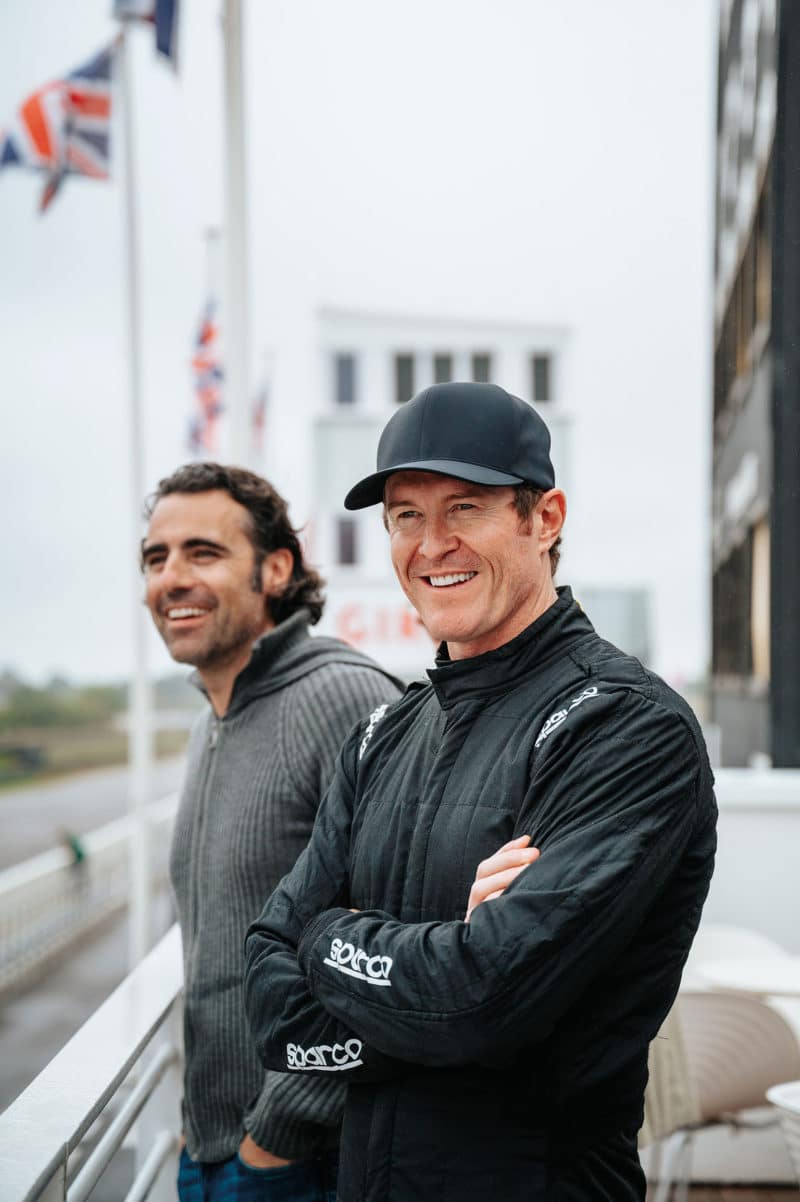
Franchitti, of course, has some experience racing 1960s machines – until recently he was the owner of Jim Clark’s 1964 Lotus Cortina
Stop press…
In the event Scott will need to wait another year for the chance to win his seventh title after Will Power clinched the 2022 crown in September. However, he and Dario brought their E-Type Jaguar home sixth in the Stirling Moss Memorial Trophy at the Revival.
“We wanted a top 10 finish,” said Scott, “I had a blast. It’s been a wonderful weekend. That was my first standing start with clutch and manual shift for many, many years. It was super exciting. I want to do some more of this.”
